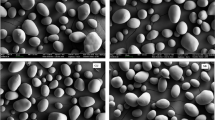Summary
The relationships of specific gravity to total and non-protein nitrogen and to ascorbic acid content of Ontario potatoes, a variety susceptible to precooking discoloration, were studied.
Total and non-protein nitrogen, expressed on a dry weight basis, decreased as specific gravity increased to the mean specific gravity for the variety. Potatoes having the mean specific gravity had the lowest total and non-protein nitrogen content. Both total and non-protein nitrogen were significantly higher in the center than in the cortex tissue.
High specific gravity was significantly correlated with high ascorbic acid content. Tubers of low specific gravity showed a greater loss of ascorbic acid during storage than those of high specific gravity.
Similar content being viewed by others
Literature Cited
Chick, H. and E. B. Slack. 1949. Distribution and nutritive value of the nitrogenous substances in the potato. Biochem. J. 45: 211.
Contrufo, C. and J. Levitt. 1957. Protein changes associated with the emergence of potato tubers from the rest period. Plant Phys. 32 (Supp.): 26.
Cotter, D. J. 1954. Black spot of potatoes as influenced by chemical modifiers. Unpubl. Master’s Thesis, Cornell University, Ithaca, New York.
Jacob, W. C. 1959. Studies on internal black spot of potatoes. Cornell Univ. Agr. Expt. Sta. Memoir 368.
Mondy, N. I. and B. P. Klein. 1961. The interrelationships of potato discoloration, polyphenol oxidase activity, and nitrogen content of potatoes. Am. Potato J. 38: 14.
Nelson, W. L. and G. F. Somers. 1945. Determinations of ascorbic acid-Application of the indophenol-xylene method to determine in large numbers of tomato and tomato juice samples. Ind. Eng. Chem. (Anal. Ed.) 17: 754.
Overly, D. J. 1957. The effect of variety, maturity, and storage on ascorbic acid content of potatoes as related to black spot. Unpubl. Master’s Thesis, Cornell University, Ithaca, New York.
Ponting, J. D. and M. A. Joslyn. 1948. Ascorbic acid oxidation and browning in apple tissue extracts. Arch. Biochem. 19: 47.
Sawyer, R. L. and G. H. Collins. 1960. Black spot of potatoes.Am. Potato J. 37: 115.
Scudder, W. T. 1951. Black spot of potatoes. Unpubl. PhD. Thesis, Cornell University, Ithaca, New York.
Scudder, W. T., W. C. Jacob and H. D. Thompson. 1950. Varietal susceptibility and the effect of potash on incidence of black spot in potatoes. Proc. Am. Soc. Hort. Sci. 56: 343.
Shallenberger, R. S. 1955. The browning reaction in potato chips. Unpubl. PhD. Thesis, Cornell University, Ithaca, New York.
Steward, F. C. and H. E. Street. 1947. The nitrogenous constituents of plants. Ann. Rev. of Biochem. 16: 471.
Talley, E. A., T. J. Fitzpatrick, and W. L. Porter. 1961. Chemical composition of potatoes. I. Preliminary studies on the relationships between specific gravity and the nitrogenous constituents. J. Food Sci. 26: 351.
Author information
Authors and Affiliations
Rights and permissions
About this article
Cite this article
Mondy, N.I., Rieley, P.B. Relationship of specific gravity to the nitrogen and ascorbic acid content of potatoes. American Potato Journal 41, 417–422 (1964). https://doi.org/10.1007/BF02908894
Accepted:
Issue Date:
DOI: https://doi.org/10.1007/BF02908894




